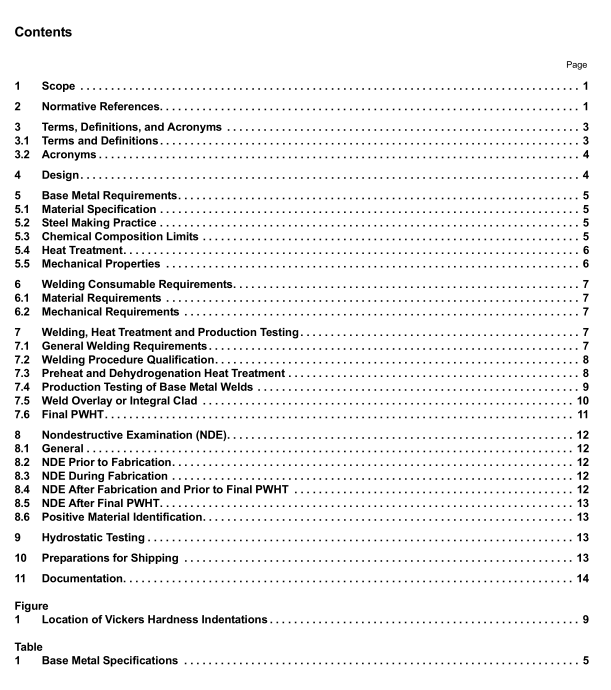API RP 934-E pdf download

API RP 934-E pdf download Recommended Practice for Materials and Fabrication of 1 1 / 4 CR- 1 / 2 Mo Steel Pressure Vessels for Service Above 825 °F (440 °C)
NOTE The J-factor is not applicable to these alloys, and an X-bar limit has been adopted as a means of resticting theconcentration of elements that contribute to reheat cracking of the steel.
The chemistry restrictions described above along with other aspects of this RP are designed to provide the steel withresistance to the reheat cracking phenomenon described in API 938-A.
5.4Heat Treatment
All product forms shall be annealed, normalized and tempered (N&T) or quenched and tempered (Q&T) to meet therequired mechanical properties. For thickness > 2 in. (50 mm), Q&T may be required to meet fracture toughnessspecifications for the steel. Annealed steel and lower Class levels should be specified for applications involving hightemperature service where the primary failure mechanism is creep rupture.For equipment exposed to cyclic serviceand where fatigue is an important factor the use of N&T or Q&T heat treatment and higher class levels may be moreappropriate.
5.5Mechanical Properties
5.5.1 Location of Test Specimens
Test specimens for establishing the tensile and impact properties shall be removed from the following locations:
a) Plate—From each mother-plate with the same heat treatment, transverse to the rolling direction in accordance
with SA-20 at the standard test locations and at the 1/2T location. When permitted by the applicable productspecification , coupons for all tests shall be obtained from the 1/2T location only. If required,1/2T specimens shallbe used for hot tensile tests.
NOTE lIf multiple plates are cut from one motherplate only one set of specimens from the motherplate is required.
b) Forging—From each heat transverse to the major working direction in accordance with SA-182 or SA-336,andtest specimens shall be taken at 1/z2T of the prolongation or of a separate test block. A separate test block , if used,shall be made from the same heat and shall receive substantially the same reduction and type of hot working asthe production forgings that it represents and shall be of the same nominal thickness as the production forgings.The separate test forging shall be heat treated in the same furnace charge and under the same conditions as theproduction forgings.
c) Pipe—From each heat and lot of pipe, transverse to the major working direction in accordance SA 530 except that
test specimens shall be taken from 1/2T.
5.5.2Tensile Test Requirements
5.5.2.1 Tensile testing of plates and forging materials shall comply with the applicable code(s) and the followingadditional requirements.
5.5.2.2 Test coupon shall be heat treated to represent the maximum post-weld heat treatment per 3.1.6.
5.5.2.3Tensile properties at room temperature shall meet the requirements of the applicable code(s).
5.5.3 lmpact Testing Requirements
Charpy V-notch (CVN) impact testing shall be performed for all11/4Cr-1/2Mo steel material used for pressurecontaining components except bolting. CVN impact tests shall comply with the applicable code(s) and the followingadditional requirements.
a) Test coupons from forgings shall be oriented transverse to the major direction of metal flow.
oeaaHaanse rsate365百台承群学颛皙氢珑涎英群雠
listed above, retesting at 0 °F(-18°C is not needed.
c) Lateral expansion and percent shear shall also be reported for information.6 welding Consumable Requirements
6.1Material Requirements
6.1.1 The deposited weld metal, from each lot or batch of welding electrodes and each heat of fller wires, and eachcombination of filler wire and flux, shall match the nominal chemical composition of the base metal to be welded.
6.1.2The following chemical composition limits shall be controlled to improve resistance to reheat cracking. Thechemical composition restriction applies to the heat analysis.
X-bar = (10P + 5Sb + 4Sn +As)/ 100≤12
where
P, Sb, Sn, and As are in ppmcis 0.15 %maximumcu is 0.20 % maximumNiis 0.30 % maximum
6.1.3 Low hydrogen welding consumables, including fluxes, having a maximum of 8 ml of difusible hydrogen forevery 100 g of weld metal, per AWS A4.3, shall be used. They shall be baked, stored, and used in accordance withmanufacturer’s instructions (holding in electrode oven, length of time out of oven, etc).
6.2Mechanical Requirements
6.2.1 Tensile Properties
The tensile properties of the deposited weld metal shall meet those of the base metal in accordance with 5.5.2.
6.2.2lmpact Properties
Prior to the start of fabrication, each lot of electrodes, heat of filler wire, and combination of lot of flux and heat of wire,shall be screened by impact testing of weld deposit in accordance with 5.5.3.
7 welding, Heat Treatment and Production Testing
7.1General Welding Requirements
7.1.1 Base metal surfaces prior to welding or applying weld overlay shall consist of clean metal,prepared bymachining. grinding or blast cleaning.









